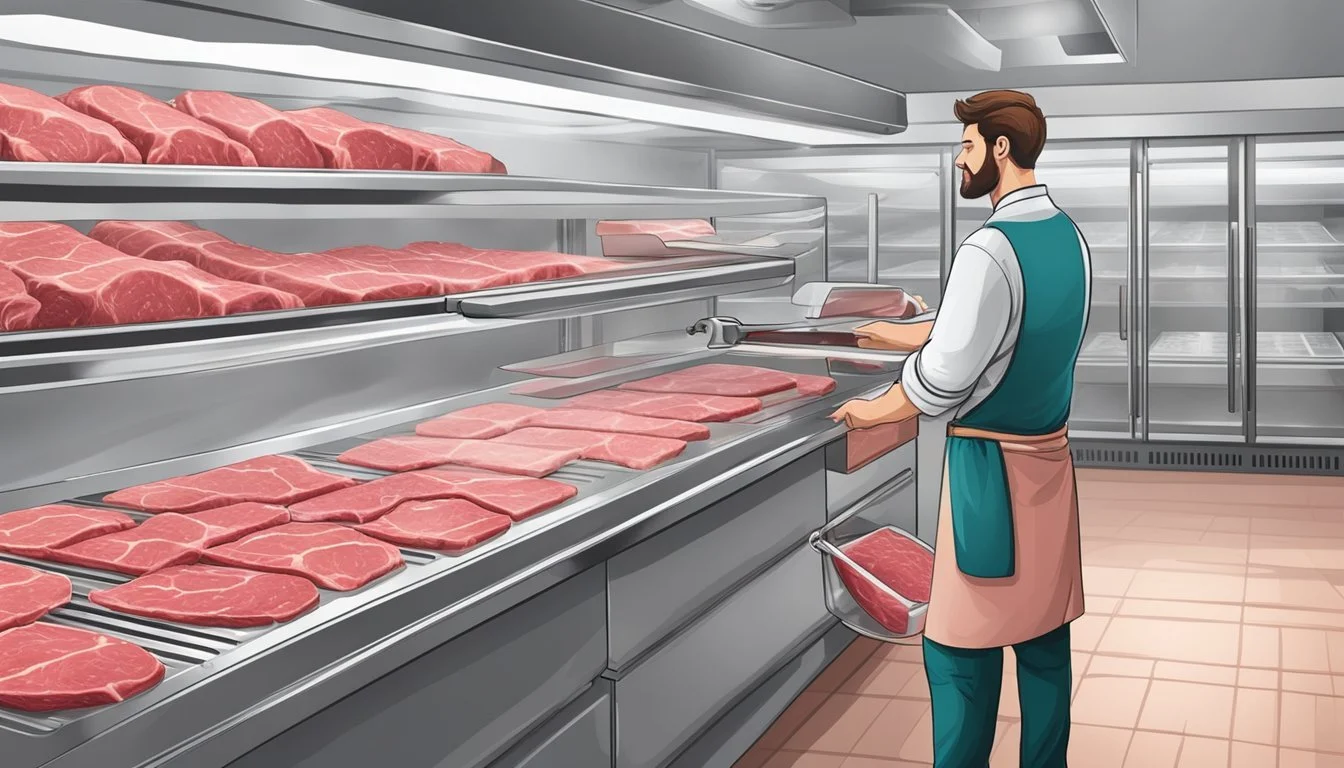Is Beef Carpaccio Gluten-Free?
Understanding its Ingredients and Preparation
Beef Carpaccio (What wine goes well with beef carpaccio?), traditionally an Italian appetizer, is a dish that raises questions regarding its compatibility with gluten-free diets. At its core, Carpaccio consists of raw beef sliced thinly and typically seasoned with oils, lemon juice, and cheese. Given that the main component is beef, the meat itself is inherently gluten-free, as it is purely a protein and does not contain gluten, which is found in grains like wheat, barley, and rye.
However, the gluten-free status of Beef Carpaccio can be complicated by additional ingredients. Seasonings, dressings, and garnishes that accompany the beef can contain gluten. It is common for the dish to be topped with shaved Parmesan or Pecorino, which are gluten-free cheeses, but some recipes may incorporate dressings or marinades that include gluten-containing components. Moreover, Beef Carpaccio is often served with bread or croutons, which will not be suitable for those on a gluten-free diet unless specifically made from gluten-free grains.
The key to ensuring Beef Carpaccio meets gluten-free requirements relies on examining all the accompanying ingredients closely. Chefs and manufacturers who aim to produce a gluten-free variant must carefully select components and avoid cross-contamination to provide a safe and enjoyable dish for those avoiding gluten. It is essential for individuals with gluten sensitivities or celiac disease to inquire about all elements of the dish before consumption to ensure their dietary needs are met.
What Is Beef Carpaccio?
Beef Carpaccio is an Italian dish that has been savored for its simplicity and rich flavor, tracing its roots back to mid-20th century Venice.
Historical Background
The creation of beef carpaccio is attributed to Giuseppe Cipriani at the renowned Harry's Bar in Venice during the 1950s. Named in homage to the Venetian painter Vittore Carpaccio, known for his vividly red and white tones, this dish reflects the colors seen in Carpaccio's artwork, capturing a part of Italian culinary and art history.
Definition and Key Characteristics
Traditionally, beef carpaccio consists of thinly sliced raw beef, such as tenderloin, which is served chilled. Key characteristics of authentic carpaccio include:
Beef Quality: high-quality, fresh beef is critical to minimize foodborne risks.
Preparation: beef is sliced paper-thin, often aided by chilling or partially freezing to facilitate slicing.
Presentation: typically drizzled with olive oil, lemon juice, and served with capers, (What wine goes well with capers?) onions, and sometimes Parmesan cheese or arugula.
In contemporary iterations, the term 'carpaccio' has broadened to include thinly sliced raw meat or fish, but the classic version remains a celebration of beef's delicate flavor and texture.
Gluten-Free Considerations
When evaluating beef carpaccio for a gluten-free diet, it is crucial to assess both the presence of gluten in the dish itself and the potential for cross-contamination during preparation.
Gluten Presence in Carpaccio
Beef carpaccio, in its most basic form, is gluten-free since it consists primarily of thin slices of raw beef. However, the garnishes or seasoning used in carpaccio recipes may incorporate ingredients that contain gluten. Marinades, sauces, or dressings that accompany beef carpaccio could have gluten-containing ingredients like soy sauce, malt vinegar, or certain thickeners. It is essential for consumers to verify the gluten-free status of these additional elements to ensure the entire dish is safe to consume on a gluten-free diet.
Cross-Contamination Risks
When preparing beef carpaccio, attention must be given to preventing gluten cross-contamination. This is a particularly pressing concern in kitchens where gluten-containing and gluten-free foods are handled simultaneously. Cross-contamination can occur through:
Shared cutting surfaces and utensils
Hands that have touched gluten-containing foods
Common ingredients like salt and pepper that might have been cross-contaminated
To minimize this risk, one must use clean equipment and enforce strict kitchen protocols, such as preparing gluten-free dishes first or in a dedicated gluten-free area.
Nutritional Profile of Beef Carpaccio
Beef Carpaccio, a dish traditionally made with raw, thinly sliced lean beef, is known for its delicate flavor and tender texture. Its nutritional value can be significant for those looking to incorporate lean proteins into their diet.
Nutritional Analysis
Nutritional values for a standard serving size of Beef Carpaccio are typically as follows:
Calories: Approximately 181 per serving
Total Fat: 13g
Saturated Fat: 5.9g
Trans Fat: 0.1g
Polyunsaturated Fat: 1.1g
Monounsaturated Fat: 5.8g
Professional nutritionists often stress the importance of looking beyond calories and examining the macronutrient content of foods. Lean beef, such as that used in Beef Carpaccio, is a good source of protein and provides essential vitamins and minerals.
Health Benefits and Concerns
Beef Carpaccio offers several health benefits due to its nutritional components:
Protein: Essential for muscle repair and growth.
Fats: A source of energy and necessary for the absorption of vitamins.
However, there are also concerns to consider:
Saturated Fat: High levels can increase the risk of heart disease.
Raw Meat: There is a risk of foodborne illness; proper handling and hygiene are critical.
Individuals should consult with a professional nutritionist to tailor their dietary choices to their specific health needs, including considerations around gluten and other dietary restrictions.
Preparing Beef Carpaccio at Home
Beef carpaccio is an elegant dish that requires precision in preparation. Key elements include selecting a premium cut of beef, slicing it to the appropriate thinness, and presenting it with complementary accompaniments.
Selecting the Right Beef Cut
The ideal cut for beef carpaccio is the beef tenderloin (What wine goes well with beef tenderloin?), which is known for its tenderness and delicate flavor. This choice cut, also referred to as a beef fillet, is devoid of fat and connective tissue, making it ideal when sliced thinly. A butcher can assist in choosing a fresh, high-quality piece, which is critical for both flavor and safety.
Slicing the Meat Properly
To achieve the characteristic thinly sliced beef for carpaccio, the tenderloin should be firm but not completely frozen. Wrapping the beef in plastic wrap and placing it in the freezer for approximately 1-2 hours achieves the desired firmness. One can then use a sharp knife to slice the beef across the grain into nearly translucent rounds, typically around 1/8-inch thick. To maintain consistency, one may press the slices between two sheets of parchment paper with a rolling pin.
Carpaccio Serving Suggestions
After slicing, it's essential to arrange the beef in a single layer on a chilled plate. Traditional carpaccio is often garnished with arugula, capers, and a drizzle of vinaigrette. Each serving is typically garnished right before serving to maintain freshness. Home chefs can be creative by adding their personal touch through garnishes and dressings, but these should complement rather than overwhelm the delicate beef flavor.
Accompaniments and Dressings
When preparing beef carpaccio, the choice of garnishes and dressings is paramount to complement the dish's delicate flavors. Using the right ingredients can enhance the natural taste of the beef without overpowering it.
Traditional Garnishes
Beef carpaccio pairs exceptionally well with a bed of arugula, which offers a peppery bite that contrasts the meat's tenderness. Shavings of Parmesan cheese add a nutty and salty dimension that melds seamlessly with the beef. To introduce a zesty freshness, fresh lemon juice is often drizzled over the top.
In the realm of garnishes, the inclusion of capers can provide a tangy pop of flavor that balances the richness of the meat. A classic Italian approach is to finish the dish with a generous grinding of black pepper, which imparts a mild heat and fragrant accent.
For Garnishes:
Arugola: A base of peppery greens.
Parmesan: Saltiness and umami.
Lemon Juice: Adds bright acidity.
Black Pepper: Aromatic warmth.
Capers: Salty and briny notes.
Sauce and Dressing Options
A key element in beef carpaccio is its dressing. Extra-virgin olive oil is a staple, often simply drizzled on top to accentuate the meat's flavor with its fruity undertones. For those seeking decadence, a vinaigrette made from olive oil, lemon juice, Dijon mustard, and a touch of honey can offer a harmonious blend of sweet and tangy notes.
For a richer dressing option, one could whisk together mayonnaise with lemon juice, capers, and herbs, creating a creamy and luscious accompaniment. When preparing the salad accompanying the carpaccio, remaining vinaigrette can dress the greens for a cohesive flavor throughout the dish.
For Dressings:
Extra-Virgin Olive Oil: Pure and simple.
Vinaigrette: Ideal for a citrusy lift.
Mayonnaise-Based Sauce: Creamy indulgence.
By carefully pairing these traditional garnishes and adeptly chosen dressings, one ensures that the beef carpaccio dish is both gluten-free and replete with textures and tastes to delight the palate.
Alternative Variations
While beef carpaccio is traditionally made with thinly sliced raw beef, there are numerous variations that cater to different dietary needs and preferences. Fish carpaccio and vegetarian or vegan alternatives offer an inclusive way to enjoy this dish while adhering to dietary restrictions.
Fish Carpaccio
Fish carpaccio provides a delectable alternative for those seeking options beyond beef. Typically made with raw fish, the most common types used are salmon and cod. The fish is sliced into extremely thin sheets and often seasoned with olive oil, lemon juice, and herbs.
Salmon Carpaccio: It boasts a rich, buttery flavor that pairs well with capers and red onions.
Cod Carpaccio: A lighter option, it's complemented by citrus-based dressings which accentuate its delicate taste.
Vegetarian and Vegan Options
For vegetarians and vegans, there are plant-based versions of carpaccio that maintain the essence of the dish without any meat or fish. Some popular ingredients include:
Bresaola-style vegetables like beets, sliced thinly to mimic the traditional meat version.
Citrus or vinegar-based dressings to add brightness and contrast to the earthy flavors of the vegetables.
These meat-free alternatives provide a creative canvas for a variety of toppings and seasonings, making them not only accessible to those with dietary restrictions but also to anyone looking to explore new flavors within the realm of carpaccio.
Serving and Dining Tips
When serving beef carpaccio as a gourmet appetizer, presentation and beverage pairing are pivotal. Achieving an elegant presentation heightens the dining experience, while the right wine or beverage enhances the delicate flavors of the dish.
Presentation Techniques
For an impeccable presentation of beef carpaccio, arrange thin slices of the beef on a plate in a single, overlapping layer. Garnish with shaved parmesan cheese, which adds a nutty richness, and a handful of baby arugula for a peppery freshness that complements the meat. The plate can be finished with a drizzle of olive oil and a squeeze of fresh lemon juice. Some chefs may also add a touch of black pepper or capers for extra flavor.
Do:
Use a white or neutral-colored plate to make the vibrant colors of the dish stand out.
Scatter a few drops of aged balsamic vinegar for an aesthetic and flavorful accent.
Don't:
Overcrowd the plate with too many garnishes which can overpower the beef carpaccio.
Pairing With Wines and Beverages
The ideal beverage pairing for beef carpaccio depends on the preference of the diner but generally, a light-bodied red wine or a crisp white wine complements the dish well.
Beverage Type Recommended Options Red Wine Pinot Noir, Beaujolais White Wine Sauvignon Blanc, Chardonnay Non-Alcoholic Sparkling water with lemon
The tannins in red wine can interact beautifully with the meat's richness, while the acidity in white wine provides a palate-cleansing effect. Non-alcoholic options such as sparkling water with a twist of lemon can refresh the palate without competing with the flavors of the carpaccio.
Food Safety Concerns
When preparing beef carpaccio, which consists of thin slices of raw meat, it is essential to consider the risks of foodborne illness and to implement stringent hygiene practices to ensure safety.
Raw Meat Consumption
Consuming raw meat carries an inherent risk of foodborne illnesses caused by bacteria such as Salmonella and E. coli. Beef carpaccio should be made from high-quality beef that is handled and prepared correctly to minimize these risks. The beef should be fresh and sourced from reputable suppliers that adhere to strict safety standards.
Storage: Raw beef must be stored at or below 40 degrees Fahrenheit.
Surface preparation: Clean, non-porous surfaces like stainless steel are preferred for slicing meat. Avoid porous materials like wood, which can harbor bacteria.
Parchment paper: Use parchment paper to separate individual slices and prevent cross-contamination.
Cooking notes: Although beef carpaccio is traditionally served raw, it's crucial to understand that cooking meat to the proper internal temperature is a reliable method to eradicate pathogens.
Best Practices for Hygiene
To minimize the risk of contamination, strict hygiene practices are indispensable throughout every stage of preparing beef carpaccio.
Handwashing: Always wash hands thoroughly with soap and water before handling any food and after touching raw meat.
Utensils and surfaces: Disinfect knives, cutting boards, and any other surfaces that come into contact with raw beef.
Separation: Keep raw beef separate from other ingredients to prevent the spread of bacteria.
Inspection: Prior to purchase, inspect the meat for a fresh appearance and smell to ensure quality.
By adhering to these food safety guidelines, one can reduce the potential health risks associated with the consumption of raw meat dishes like beef carpaccio.
Purchasing and Storing Tips
When preparing beef carpaccio, the freshness and quality of the beef are paramount. Equally important is how one stores the beef to ensure it remains safe for consumption and retains its desired characteristics.
Choosing Quality Beef
For beef carpaccio, customers should look for beef eye fillet or beef tenderloin, as these cuts are lean and tender—ideal for the dish. The beef should have a vibrant red color, indicative of freshness. It ought to feel firm to the touch and have a slight sheen, with no discolored spots or excessive liquid in the packaging.
When selecting beef for carpaccio, always buy from a reputable source.
Opt for beef that has been freshly cut or properly refrigerated.
Storage for Freshness and Safety
Once purchased, beef for carpaccio should be stored meticulously to prevent bacterial growth and maintain its quality. Initial storage for the preparation of carpaccio often involves freezing.
Freeze the beef shortly after purchasing by wrapping it tightly in plastic wrap, which can be kept in the freezer for 1 hour or until firm enough to slice thinly.
Refrigerate the raw slices if not consumed immediately. Place them on a tray covered with parchment paper, covered with plastic wrap, for up to 24 hours.
For longer-term storage of beef, customers should:
Keep beef in the coldest part of the refrigerator if it is to be used within 1-2 days.
Store beef in the freezer if it will not be used promptly. Wrapped beef can typically be stored safely for up to 3 months.
Remember, when it comes to beef carpaccio, freshness and proper storage are crucial to both the safety and flavor of the final dish.









